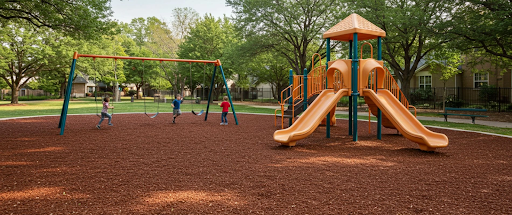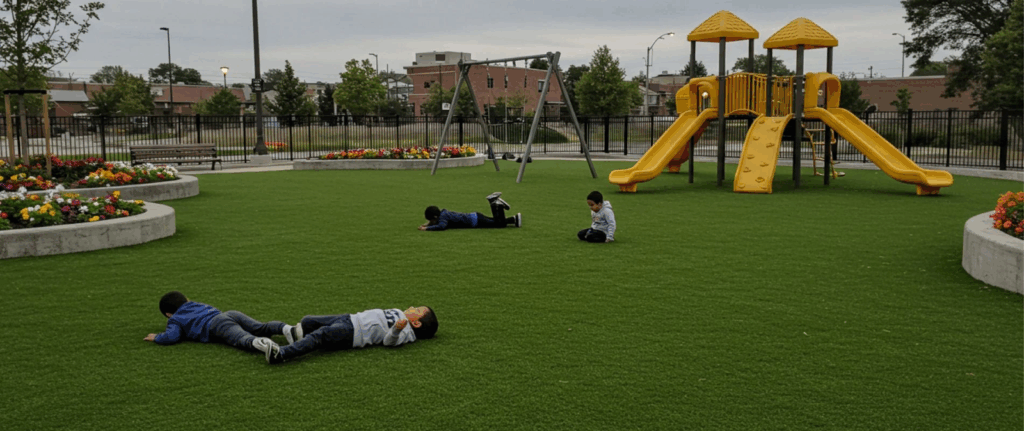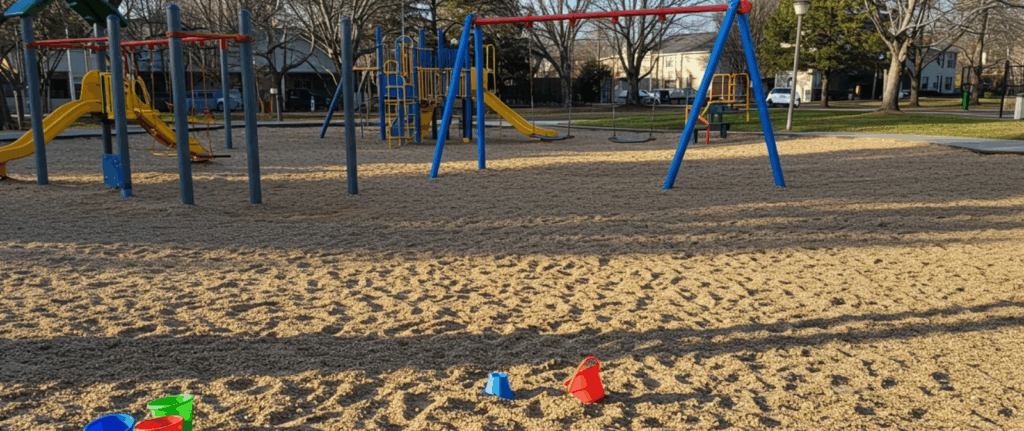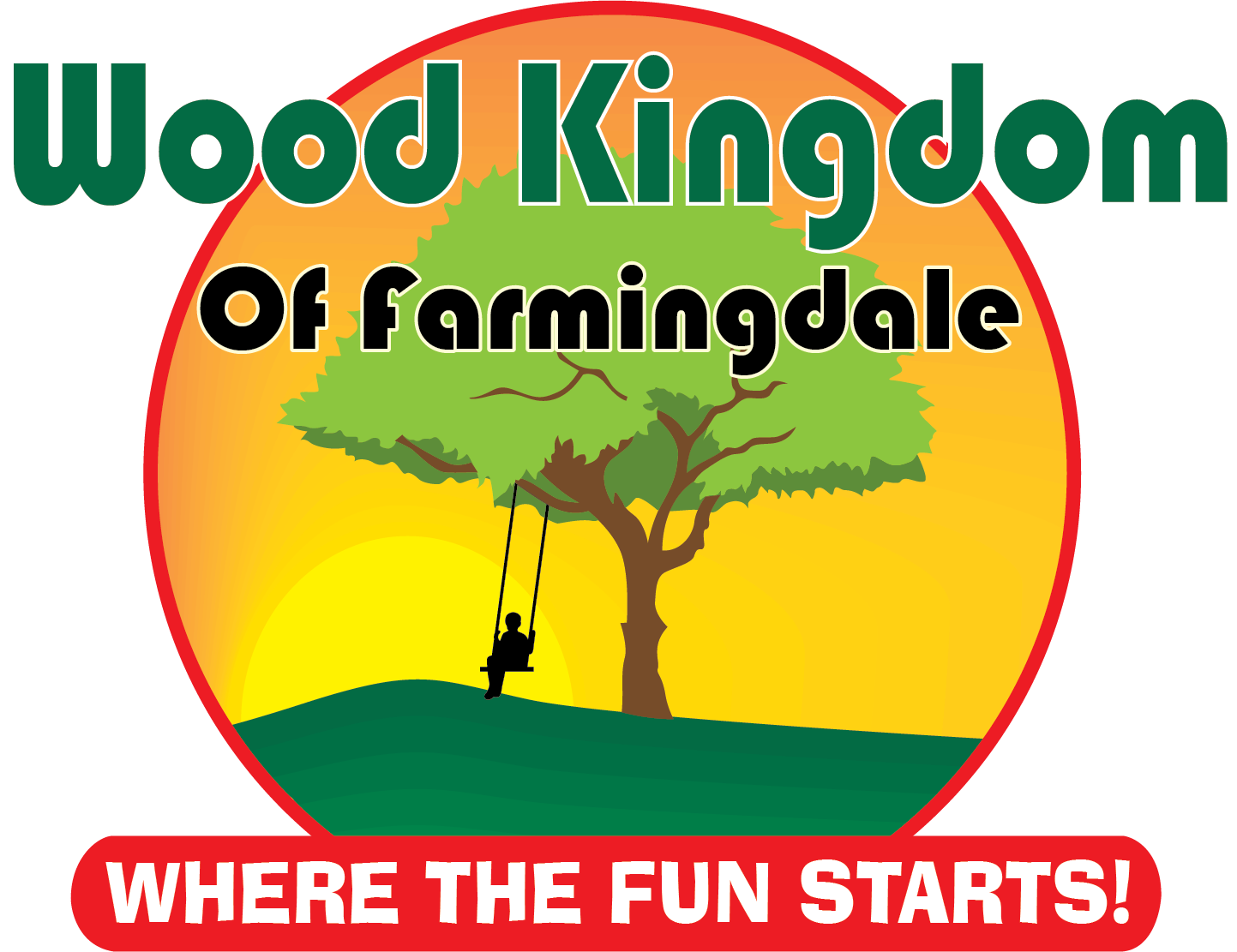When creating a playground, safety always comes first. While the swings and slides may get all the attention, the surface underfoot plays a critical role in creating a safe environment for children. According to the National Safety Council, most playground injuries stem from falls, making the right choice of playground surface options an essential consideration. This guide will walk you through the safest materials for playgrounds, their unique benefits, and how to choose the best one for your needs from trusted providers like Wood Kingdom West.
Why Playground Surfaces Matter
- Safety First: The primary reason playground surfaces matter is to cushion falls and reduce the risk of injuries. Surfaces like grass or dirt may seem soft but often harden over time, increasing the likelihood of harm when children fall. Opting for impact-absorbing materials like shredded rubber or engineered wood fiber can significantly reduce injuries.
- Accessibility: A good playground surface ensures inclusivity, allowing children of all abilities to play freely. Materials like poured-in-place rubber or rubber tiles are ADA-compliant, providing a smooth, stable surface for wheelchairs and strollers.
- Durability and Maintenance: Not all playground surfaces require the same level of upkeep. Options like sand or mulch may need frequent replenishment, while artificial turf or rubber mats provide long-term durability with minimal maintenance, making them ideal for high-use areas.
- Environmental Considerations: Some surfaces are more eco-friendly than others. Recycled rubber, for example, is a sustainable choice that repurposes waste materials, while natural options like wood chips can decompose over time, reducing environmental impact.
- Cost-effectiveness: Budget plays a significant role when selecting a playground surface. While initial costs of rubber tiles or turf might be high, their longevity often makes them more cost-efficient over time compared to materials requiring constant replacement.
- Aesthetic Appeal: The right surface can also enhance the visual appeal of a playground. Brightly colored rubber or turf allows for creative designs and themes, making the space not only safer but more inviting for children.
The 5 Best Playground Surface Options


1. Engineered Wood Fiber (EWF)
Engineered wood fiber is a popular eco-friendly option for outdoor play flooring. It consists of small wood chips that create a soft, cushioned surface capable of absorbing impact.
Benefits:
- Excellent Shock Absorption: EWF is highly effective at absorbing impact, making it one of the top safe playground materials.
- Cost-Effective: Generally one of the most budget-friendly initial installation options.
- Natural Appearance: Blends well with outdoor environments.
- Environmentally Friendly: Often made from recycled wood products.
Downsides:
- Requires Regular Maintenance: It needs to be raked and topped up regularly to maintain adequate depth, especially under high-traffic areas like swing sets and slide exits, which is a key consideration for outdoor play flooring.
- Accessibility Challenges: Can be difficult for wheelchairs or strollers to navigate, making it less ideal for inclusive playgrounds.
- Can Displace: Kids can kick or throw it, leading to uneven surfacing.
- May Compact: Over time, EWF can compact, reducing its shock-absorbing qualities.
Best For: Schools, parks, and large public playgrounds where budget is a primary concern and regular maintenance is feasible.


2. Rubber Mulch
Rubber mulch is made from recycled rubber materials, like old tires, and is a durable alternative to traditional wood mulch.
Benefits:
- Superior Shock Absorption: Often boasts higher critical fall heights than EWF, making it a very safe playground material.
- Low Maintenance: Doesn’t decompose or compact easily, requiring less topping up than wood fiber. It’s a low-maintenance option among playground surfaces.
- Quick Drying: Drains water efficiently, leading to less downtime after rain.
- Durable and Long-Lasting: Resists wear and tear exceptionally well.
- Pest Resistant: Doesn’t attract insects or rodents.
Downsides:
- Higher Upfront Cost: More expensive than EWF for initial purchase and installation.
- Can Get Hot: Darker colors can absorb and retain heat, making the surface hot in direct sunlight.
- May Contain Steel Wire: Some lower-quality rubber mulch may contain small pieces of steel wire, though reputable suppliers ensure it’s removed.
Best For: Any playground where safety and low maintenance are top priorities, and the budget allows for a higher initial investment. Often chosen for premium residential or commercial playgrounds.


3. Poured-in-Place (PIP) Rubber
PIP rubber is a seamless surfacing solution known for its durability and safety. It’s crafted by pouring rubber granules on-site and binding them with a polyurethane mixture.
Benefits:
- Superior Safety: Provides excellent, consistent impact absorption across the entire surface, making it one of the safest playground surface options.
- Highly Accessible: Smooth, level, and firm, making it ideal for wheelchairs, strollers, and those with mobility challenges. This is crucial for truly inclusive outdoor play flooring.
- Low Maintenance: Easy to clean and requires minimal ongoing maintenance. No raking or topping up needed.
- Design Flexibility: Available in a wide range of colors and patterns, allowing for creative designs and integrated games.
- Durable: Very long-lasting with proper installation and care.
Downsides:
- Highest Upfront Cost: Significantly more expensive than loose-fill materials.
- Professional Installation Required: Installation is a specialized process that needs experienced professionals.
- Can Get Hot: Darker colors can absorb a lot of heat, similar to rubber mulch.
- Repairs Can Be Noticeable: While durable, repairs can sometimes show seams or color differences.
Best For: Public parks, schools, daycares, and any setting where accessibility, maximum safety, and low long-term maintenance are paramount. It’s often considered the gold standard for safe playground materials.


4. Artificial Grass or Turf
Artificial grass combines aesthetics with utility, mimicking the look of natural grass while providing a safer, cushioned playground surface.
Benefits:
- Aesthetic Appeal: Looks like natural grass year-round, enhancing the visual appeal of the play area.
- Excellent Shock Absorption: The infill system provides high critical fall heights.
- Good Drainage: Designed to drain water quickly.
- Low Maintenance: No mowing, watering, or fertilizing. Minimal upkeep compared to natural grass.
- Clean: No mud or dirt, keeping children and nearby areas cleaner.
- Accessible: A relatively firm and even surface, offering good accessibility.
Downsides:
- High Upfront Cost: Similar to PIP rubber in terms of initial investment.
- Can Get Hot: Like other rubber-based materials, it can retain heat.
- Odor: Some infill materials can have a rubbery odor, especially in hot weather.
Best For: Playgrounds where aesthetics, safety, and low maintenance are priorities, and a natural grass look is desired. Increasingly popular for both residential and commercial applications.


5. Sand and Pea Gravel
These are traditional playground materials that have been used for decades. They create a loose surface but still absorb impact from minor falls.
Benefits:
- Very Low Cost: Highly affordable for initial purchase.
- Good Drainage: Both drain water well.
Downsides:
- Lower Critical Fall Height: Offer less impact absorption compared to EWF or rubber mulch, requiring greater depth for safety, which is a significant factor when considering safe playground materials.
- High Maintenance: Easily displaced, tracked into buildings, and can hide debris. Needs constant raking and topping up.
- Pest Attraction: Can become a litter box for animals.
- Accessibility Issues: Extremely difficult for wheelchairs.
- Hygiene Concerns: Can harbor bacteria or contain sharp objects if not regularly cleaned.
Best For:
Very low-budget projects or areas with low fall heights where supervision is constant. Generally not recommended as a primary surface for modern play structures.
How to Choose the Right Playground Surface
There’s no one-size-fits-all solution when it comes to playground surfaces. Here’s a quick checklist to help guide your decision-making process.
- Consider Safety First
Look for materials with excellent impact absorption, especially for high-use playgrounds. Surfaces like rubber mulch or poured-in-place rubber are great for absorbing shocks and reducing injuries.
- Set a Budget
While some materials like poured-in-place rubber have higher upfront costs, they save money long-term through reduced maintenance requirements.
- Account for Accessibility
If you need to meet ADA standards, opt for materials that provide wheelchair accessibility, like PIP rubber or compacted engineered wood fiber.
- Think About Maintenance
How much time and money can you commit to maintaining the surface? Low-maintenance options like artificial grass or rubber mulch might be worth the higher cost upfront.
- Choose Based on Appearance
Surface materials come in a variety of colors and finishes. Pick one that complements the rest of the playground and surrounding space.
Why Choose Wood Kingdom West
If you’re considering investing in safe and sturdy playground surfaces, Wood Kingdom West can help. With over 35 years of experience serving Long Island and the tri-state area, they’re a trusted provider of safe playground materials and installations. Whether you’re looking for rubber mulch, poured-in-place rubber, or engineered wood fiber, their expert team will guide you through the entire process from design to installation.
Build a Safer Playground
Choosing the right playground surface options ensures both safety and enjoyment for children. By investing in high-quality, durable materials, you not only create a secure play area but also enhance the overall value of your property.
For professional guidance and premium installations, trust Wood Kingdom West to bring your playground vision to life. Browse their offerings or book an appointment today to get started!
FAQs About Playground Surface Options
1. What is the safest playground surface?
Materials like poured-in-place rubber and engineered wood fiber are among the safest options. They provide excellent impact absorption to reduce injuries while meeting ADA accessibility standards.
2. How often should playground surfaces be maintained?
It depends on the material. Rubber surfaces require minimal upkeep, while loose materials like wood chips or sand need regular raking and refilling.
3. Is artificial turf good for playgrounds?
Yes, artificial turf is a durable and visually appealing option. It also has excellent drainage and provides a cushioned surface for safety.

